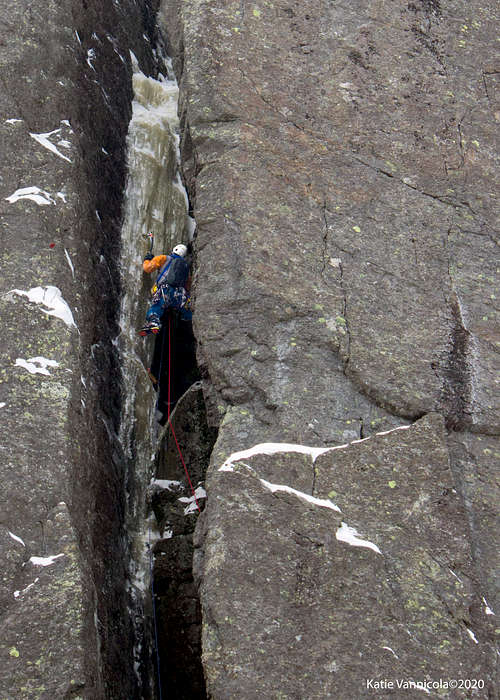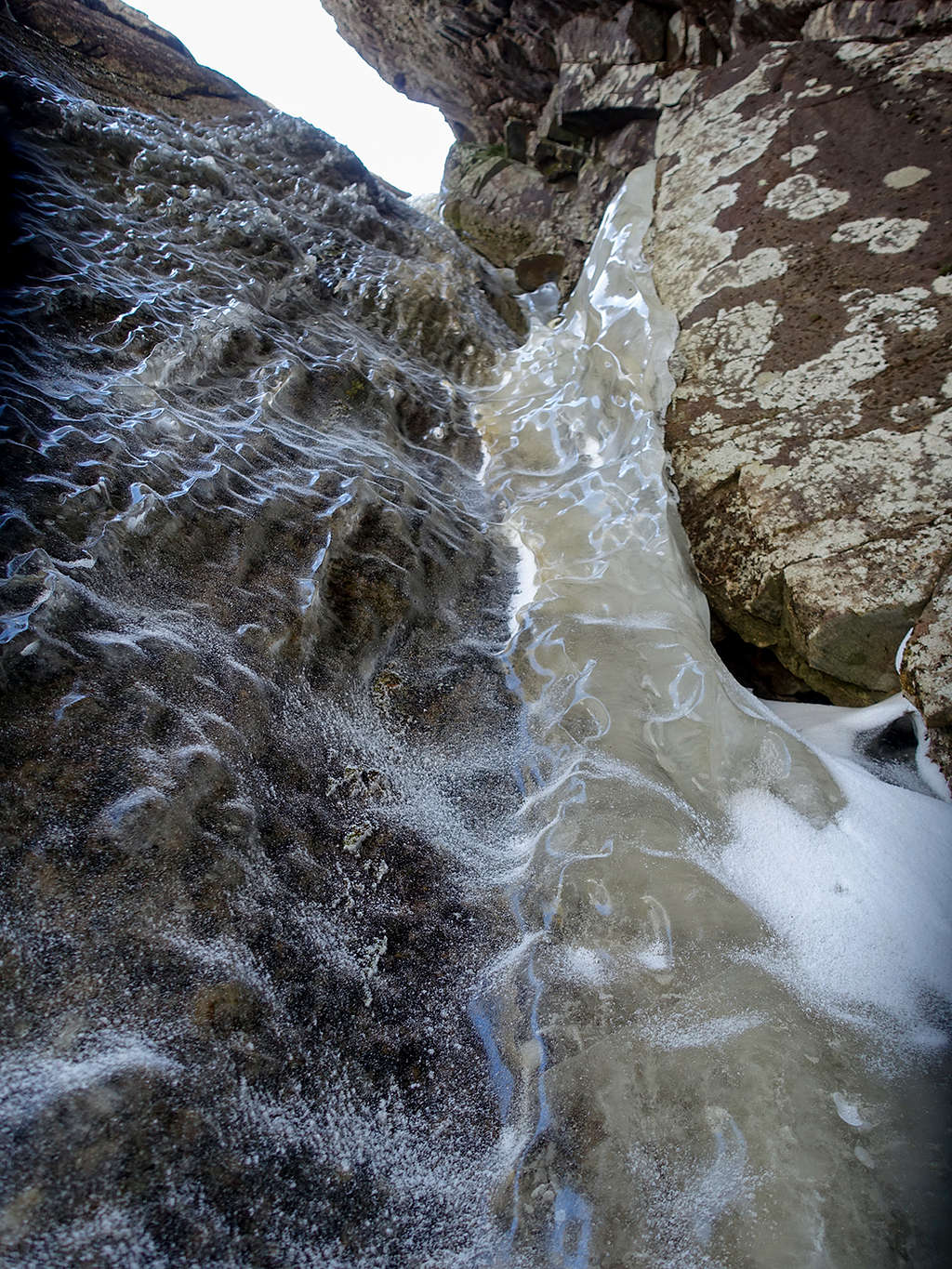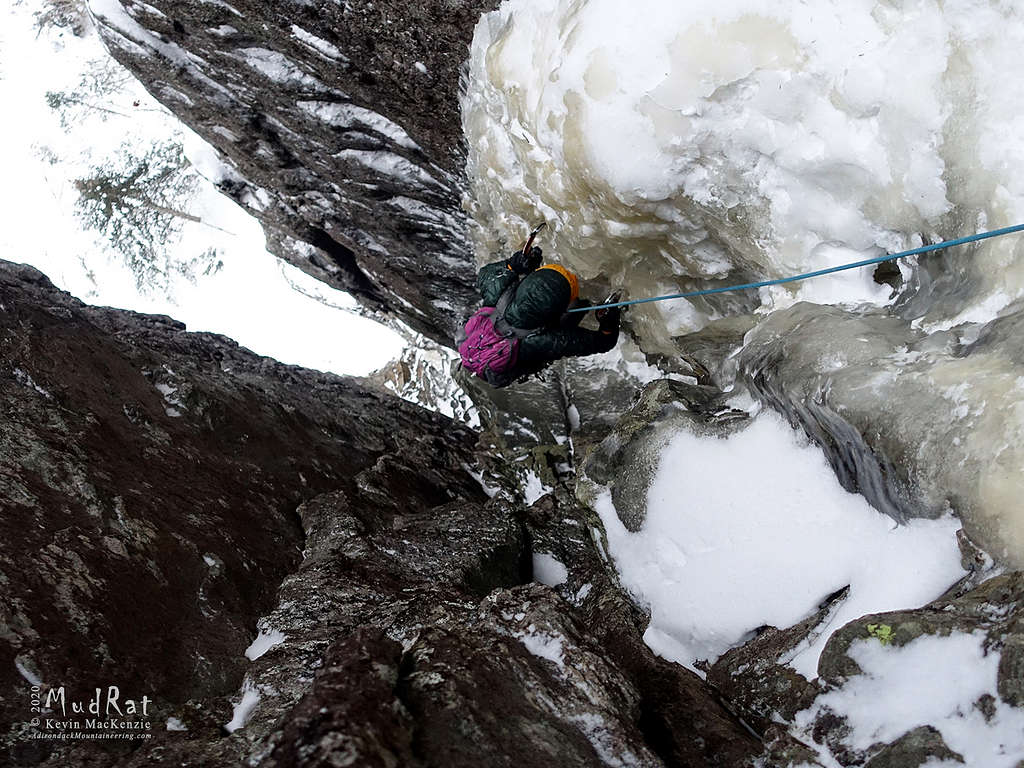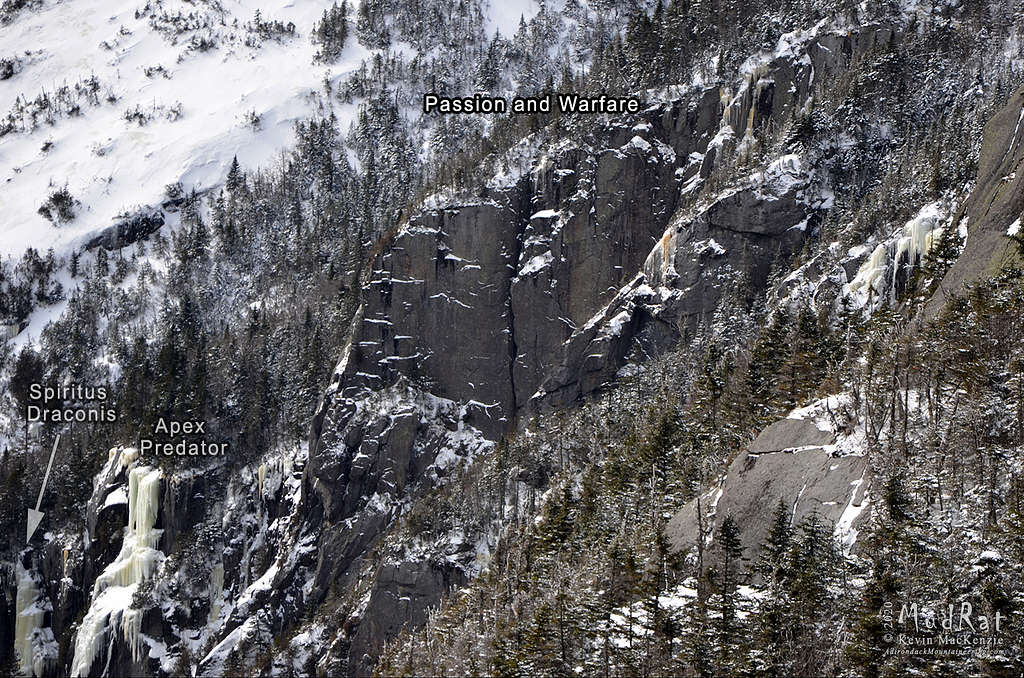|
|
Trip Report |
|---|---|
|
|
44.11196°N / 73.91179°W |
|
|
Feb 22, 2020 |
|
|
Hiking, Ice Climbing |
|
|
Winter |
Details
Duration/Length: 18.5 hours, approx.16.5 miles.
Weather: Teens F including wind chill.
Partners: Katie Vannicola, Emily Schwartz, Harold Sutton
Grade: WI5/M5 Length of Route: 160'
Photos and Video (click if vid doesn't load)
Photos: https://photos.app.goo.gl/YGveYzQzKhxcvqPg6
The Details
I often get in a slight “mental funk” a few days before a climbing trip into Panther Gorge. As much as I love the outings and head into the remote chasm to relax, the preceding days are often filled with restless nights and evenings spent studying photos or contemplating the logistics of the day. The more uncertain the target, the louder the background buzz of thoughts. The flurry of thoughts was almost deafening before this trip since I knew the target was difficult and since I’d made multiple attempts over the years.
I was first introduced to the chimney in 2014 by Adam Crofoot. We trekked in during December with him as the obvious leader. He made it partway up in brutal conditions—thin, brittle ice with a little water in the mix which ended up running down his sleeve while he was on the crux. In the end, he had to down-climb to his last piece of protection and rappel. Thereafter, the ice was always too thin for my skill set. I hoped that something someday would work out if it was meant to be.
The 2019-2020 season started productively when Laura Duncan, Brent Elliott and I put up Waking Cerberus. I wanted to continue trying backcountry projects in January, but life and weather closed the door on heading into the Gorge until this trip. I’d been talking to a few people about heading into PG; Harold Sutton, Emily Schwartz, and Katie Vannicola were eager to check it out in winter (Katie was in last summer). I figured a group of four would be fine for this line and also hoped that if I lost my nerve at the base, there’d be another leader to take the reins. Thankfully the temperatures rose and snowfall eased off which opened the perfect opportunity. We only had to fret over the conditions in the chimney. Was there ice? It’s not a primary drainage so forecasting the ice in the chimney is a matter of luck as past years have taught me.
My alarm sounded at 2:45 AM, we met at the ADK Loj at 4:00 AM, and we were walking by 4:30 after splitting the gear. The trail was firm and offered easy walking; a blessing since an approach from the Loj to this specific cliff meant nearly summiting Marcy before starting the bushwhack. As usual, I was full of energy in spirit, but tired in body so the first few hours seem like a blur. We refilled water at Indian Falls after Emily kindly (and inadvertently) made a hole by plunging into the brook. A few miles later, and we were in a blowing fog at our exit point from the trail.
I’ve more or less memorized the small gullies and knobs after jumping off the Van Hoevenberg Trail, but had a GPS packed in case we needed it. Losing climbing time tromping around the woods wasn’t in my plan. A steep ledge, small rock outcrop on the southern side of one of the gullies, and a narrow snowfield were all terrain markers that let me know we were on track. I didn’t want to pick the wrong gully and end up at the wrong cliff top. Hikers should stay clear of this area since this aspect of Marcy often ends at various cliffs.
In the Chimney

An hour of bushwhacking placed us at the entrance ramp to the Chimney Wall. A yellow ice flow at the top of the gully was a familiar sight. We descended the gully and stomped down an area to sort the gear as the sun came out in full.
I peered up into the maw holding the ice line. It looked fatter than I’ve seen it other than last April when the ice was rotten. Fat is a relative term since it was still only a veneer on the southern wall and thin until the upper curtain. I had to at least give it a try. It took me a few minutes to sort everything and calm my mind, then I stepped into the chimney with Harold on belay. Katie set up to play photographer as did Emily. Everyone then waited for two hours while I scratched my way up.
The initial 20 feet was a ramp with choss frozen in the mix. I was happy to get an ice screw as a first piece of protection after about 15 feet. Parts of the ice runnel were not bonded along the edge, but it was better than what I found last April when I sheared a 4-foot section with the first swing…before giving up. The right-hand wall had a variety of cracks for a small cam after the screw.
I stopped for a moment to enjoy the view from within the cleft; Haystack across the way, basalt and anorthosite within, and flowing ice above. I love climbing virgin ice—the texture and beauty is much more appealing than climbing a pegboard. It’s also more arduous and meant cleaning the snow off just about everything that wasn’t vertical. The narrow flow I followed was eroded from the last melt. As usual, I found this the hard way as tore a tool free with the first shoulder-tug. Another strike in the same place broke the left side off the flow—brittle. It was a slow ascent.
The first test was at an overhanging, lichen-splotched piece of trap rock. Delicate strikes enabled me to climb to its top where the ice was thicker and wider. This placed me below the second overhanging section and what I feel was the crux given the conditions at hand. The ice flow was narrower and the dry-tooling choices were poor. Additionally, my right foot kept skating on the smooth overhanging basalt. A front point embedded in the veneer on the left gave me a little confidence. I protected with a yellow alien in the center of the dike and finally hooked something with the tip of a tool and made a big move onto a crappy rest; at least there was gear in the nearby cracks. I “rested” with both feet pushed into the ice on the southern wall about 80 feet up. The dike tried to spit me out rest or not. The rock above my head, an obvious blockage in the dike that can be seen from distant photos, was the next interesting overhanging section.
The transition from the awkward rest to the thin ice on the wall got my blood flowing; a few more movements placed me on a better stance where I got a 10 cm screw. I was below a narrow ice slot. Two high sticks allowed me to ungracefully slink through the notch and flop onto a more substantial rest in a cave below the pale yellow curtain. The ice was finally fat even if it shattered easily. I took an extended break, placed a couple screws, then gathered my calm before starting up again. I felt a bit spooked given how far from civilization we were and how close to my limit I was climbing. I reassured myself that the protection was good even though “the leader never falls.”
The chimney at this point is wider than I can stem during the summer. But the ice flow eliminated that issue. Opposing feet helped me feel secure as I worked up and finally got fully on the ice. A few more swings placed me below two bulges preceding a snow gully. I felt it best to dry tool on the left wall rather than risk a tool tearing free from whatever was under the snow I yelled to Harold that the rest “was easy” though I soon ate those words.
One of the dominant features of the chimney is a huge slab capping it at the top. This was now overhead and next to the confluence of several multicolored ice flows that ended the climb. The “easy ice” was still grade 4, but the climbing was awkward, and I was tired. By the time I hooked a small pine tree at the top, I’d been climbing for 1 hour 45 minutes. I was spent. I used 11 ice screws and 7 pieces of rock pro (#3 nut, yellow alien, #3 BD cam, pink tricam, and others) in all for those who love beta.

In summary, the climb was a sustained combination of stemming, front-pointing on thin ice or placing points on positive edges of rock, chipping away at brittle ice, avoiding water-eroded ice, and full body tension. It was cerebral and stout. There were four distinct areas of slightly overhanging rock and/or ice. Nothing felt secure, though that was obviously just my opinion since the tools never tore free while I was committed to them. The only mishap of sorts was when both of my feet ripped free and I caught myself on the tools—not a problem, just a reality check that interrupted the normal rhythm of Harold’s heartbeat.
Once I got my breath, it was Emily’s turn. I couldn’t see anything until she popped out of the chimney 45 minutes later breathing heavily and commenting about a difficult and deceptive line. Her assessment made me feel a bit better given how long it took me to lead.
Katie had been taking pictures from below; a vantage point that was clear from the debris that shot out of the chimney. I still wanted some photos from a perspective within the chimney, so I rappelled down to the curtain while Emily belayed Harold. The unconsolidated sugar snow swept down the gully as I positioned myself. I believe Harold was happy with the resulting photos including flying ice chips sent with every swing, but he wasn’t happy with the wisps of snow that fell with even my slightest movement.

I’d eliminated this issue by the time Katie was climbing. She came into view as she worked the awkward ice slot and flopped onto the laminated slab. She regained her breath and stemmed up the bottom of the curtain, then climbed up the left side of the flow. Once she passed, I rappelled and attacked the food in my pack…the entire ordeal took a little longer than I anticipated. Our group was down from the route and repacking gear as the sun set. The gully climb got our blood moving again. At its top, we switched to snowshoes and prepared to bushwhack out as darkness settled.
Our herdpath from earlier had consolidated enough to aid our walk out—back up 600 vertical feet—better than tramping out a new path. We crested Marcy’s ridge and turned the headlamps off. The Milky Way as magnificent; I love night exits. It felt good to be back on the trail though we were still seven miles from the warmth of a vehicle. We needed water and food so Indian Falls made a good stop for the second time of the day, this time for a more prolonged break as Harold boiled water for dinner. We still made it back to the car by midnight which, in my opinion, is a win!
Geology of Marcy’s Trap Dike
The following paragraph might be of interest to anyone with a geological interest.
St. Lawrence University Professor of Geology, Jeff Chiarenzelli, describes the dike (Marcy’s Great Chimney) as follows, “The dike is composed of basalt, a black, fine-grained rock that often erupts on the surface or is found in feeder dikes to volcanic rocks. Similar basaltic dikes are found throughout the Adirondack region and are approximately 640 million years old. Produced in the Earth’s mantle they intruded into cracks and fractures as the eastern seaboard was rifted apart to form the Iapetus Ocean. The Iapetus Ocean formed during the cycle of continental breakup prior to the opening of the Atlantic.” The basalt in the dike is lighter from weathering. Basalt also differentiates Marcy’s dike from Colden’s whose primary trap rock is gabbro which has larger crystals.

Additional Panther Gorge Trips
- Grand Central Slide (w/Mark Lowell)
- Grand Central Slide Descent, up the Margin Slide & Skylight Bushwhack (w/Greg Kadlecik)
- Marcy to Haystack Bushwhack with Great Range Traverse-Great DeRanged Traverse(w/Greg Kadlecik)
- Marcy East Face Circumnavigation (w/Ranger Scott van Laer)-2013 Aug 24
- Marcy (East Face) Ranger on the Rock-East Face Slab (w/Anthony Seidita)-2013 Sep 6
- Haystack Slides and Haycrack Route-Day 3 of 4 days in the gorge (w/Anthony Seidita)-2014 May 1
- Haystack (V Wall) All Things Holy (w/Adam Crofoot)-2014 Jul 12
- Marcy (Agharta Wall) & Haystack (Free-Standing Pillar) Wreck of the Lichen Fitzgerald & For Whom the Lichen Tolls (w/Adam Crofoot)-2014 Aug 16
- Marcy (Agharta Wall) CrazyDog’s Halo & Watery Grave (w/Adam Crofoot)-2014 Sep 27
- A Snowy Panther Gorge Bushwhack (w/Adam Crofoot)-2014 Dec
- Marcy: A New Ice Route – Pi Day (w/Adam Crofoot & Anthony Seidita)-2015 Mar 14
- Haystack: 3 New Routes in a New Area (the Ramp Wall) (w/Allison Rooney and Adam Crofoot)-2015 May 30
- Marcy (Panther Den) Cat on a Wet Tin Roof (w/Bill Schneider)-2015 Jun 14
- Rumours of War: Opening a New Area—the Huge Scoop (w/Hunter Lombardi)-2015 Jul 11
- Marcy (Feline Wall) Kitten's Got Claws (w/Justin Thalheimer)-2015 Aug 1
- Not Every Trip to the Gorge is Perfect –No Route, but a Good Day (w/Bill Schneider)-2015 Aug 16
- Marcy (Huge Scoop) The Pride (w/Bill Schneider and Adam Crofoot)-2015 Aug 30
- Marcy (Feline Wall) Promised Land (w/Dan Plumley)-2015 Sept 19
- Tour de Gorge (w/Adam Crofoot & Allison Rooney)-2015 Nov 21
- Marcy (Panther Den) Ice Route: By Tooth and Claw (WI4) (w/Bill Schneider & Devin Farkas)-2016 Jan 30
- Haystack Ice Climbs-Orson's Tower (WI3+) and Fly By (WI3) (w/Nolan Huther)-2016 March 5
- Marcy (Agharta & Panther Den Walls)-Pioneer Anomaly & Belshazzar's Fate (w/Adam Crofoot & Alan Wechsler)-2016 May 28
- Marcy (Huge Scoop)-Predatory Instincts (w/Bill Schneider & Nolan Huther)-2016 June 4
- Marcy (Feline Wall)-Galaxy of Tears (w/Dustin Ulrich)-2016 June 17
- Marcy (Panther Den)-One for the Boys (w/Bill Schneider, Adam Crofoot & Allison Rooney) 2016 June 25
- Marcy (Agharta Wall)-Tail of Redemption (w/Bill Schneider & John Pikus) 2016 July 30
- Marcy (Panther Den Wall)-Climb After Slime & You Moss Be Kidding Me! (w/Alan Wechsler) 2016 August 6
- Marcy (East Face)-Revelations (w/Nolan Huther & Loren Swears) 2016 August 27
- Haystack (V Wall)-Psalm 23 & Windjammer (w/John Pikus & Jaryn DeShane) 2016 September 17.
- Haystack (North End)-Kitty Cake (WI2) & 2nd ascent of By Tooth and Claw (Marcy) (w/Doug Ferguson & Walker Wolf Bockley) 2017 January 14.
- Marcy (Feline Wall)-Chimaera (WI3-) (w/Matt Dobbs & Jace Mullen) 2017 February 18.
- Haystack (North End)-Ride the Lightning (WI5-) & Skip the Lightning (WI3-) (w/Alan Wechsler) 2017 March 10.
- Marcy (Chimney Wall)-Slacker Cracker (5.9) (w/Adam Crofoot & Jaryn DeShane) 2017 June 3.
- Marcy (Chimney Wall)-Marcy's Great Chimney (aka Empty Tomb) (5.8) and All Ryled Up (5.7) (w/Jaryn DeShane) 2017 June 15.
- Marcy (East Face)-Anorthofright (5.9-) (w/Steven St. Pierre) 2017 August 27.
- Marcy (Chimney Wall)-Panther's Pinnacle (5.9) (w/Steven St. Pierre) 2017 September 16.
- Marcy (Chimney Wall Area)-Spiritus Draconis (WI4+) (w/Jaryn DeShane) 2018 February 1.
- Marcy (Huge Scoop)-Charybdis (WI4) & Scylla (WI4) (w/Laura Duncan & Brent Elliott) 2018 February 17.
- Haystack (V Wall)-John 3:16 (WI4) & PG-13 (WI4) (w/Loren Swears) 2018 March 24.
- Haystack (No Man's Land)-Paws Off (5.8) (w/Steven St. Pierre) 2018 June 9.
- Marcy (Agharta Wall)-Moonraker Runout (5.8+) (w/Ken Hebb) 2018 June 16.
- Marcy (Panther Den)-Castle Column (5.9) (w/Ken Hebb) 2018 June 17.
- Marcy (Chimney Wall area)-Apex Predator (WI4-5) (w/Aaron Courain & Alan Wechsler) 2019 January 5.
- Haystack (Ramp Wall arete)-Lioness Rampant (top rope) (5.11d) (w/Allison Rooney) 2019 June 8.
- Marcy (Feline Wall)-Cracks of My Tears (5.10a) (w/Loren Swears) 2019 June 28.
- Haystack (North End)-And Then the Judgment (5.9+) (w/Steven St. Pierre) 2019 September 22.
- Marcy (Panther Den)-Waking Cerberus (WI5/M4) (w/Brent Elliott & Laura Duncan) 2019 December 28.
- Marcy (Chimney Wall)-Passion and Warfare (WI5/M5) (w/Katie Vannicola, Emily Schwartz & Harold Sutton) 2020 February 22.


